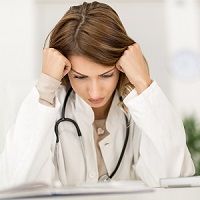Article
New Survey Highlights Growing Physician Burnout Problem
Author(s):
The majority of physicians in a new survey support hiring additional support staff in an effort to alleviate burnout symptoms.

In a new survey, 68% of US-based physicians report experiencing some level of burnout.
The survey was conducted by InCrowd, a Massachusetts-based life science market survey company, on June 6-7, involving 612 primary care physicians (PCPs) and specialists, working both in private practices and hospitals. Each doctor completed a 5-minute, 4-question InCrowd MicroSurvey.
Diane Hayes, PhD, co-founder and president of InCrowd, explained in an interview with MD Magazine® that the survey shows that burnout is a major problem plaguing the medical field that could negatively impact patients if it is not properly addressed.
“I think in looking at our data and other similar data it is pretty clear that it is a problem and as a society we are not doing anything remarkable to resolve the problem of physician burnout,” Hayes said. “It is hard to make changes in the industry….I think the risk to patients is significant enough that we should rethink that.”
Hayes suggested the best way to alleviate the burnout issues is by increasing staffing in a number of departments, including nurses, fellow physicians, administrators, and medical assistants.
She said the increased staffing will have a trickle-down effect that will allow the physician to take more days off to recharge without interrupting patient flow.
Hayes also said streamlining administrative processes with technological advancements should have a positive effect on reducing the rates of physician burnout.
Increased support staffing is supported by 66% of the respondents, while mandatory vacation time is supported by 57% and reducing patient volume is supported by 56% of those surveyed.
Overall, burnout was higher for younger physicians, with 74% of those in their 30s and 40s self-reporting the highest rates of burnout. Hayes attributed this to both a financial burden of paying back student loans and the pressures of starting a family adding to their stress.
Among different medical fields, primary care physicians reported higher burnout rates than specialists, with 79% of PCPs personally experiencing burnout compared with 57% of specialists.
“My gut sense is that primary care physicians are doing a lot of different things for their patients, they triage, maybe sending them up to a specialist for a particular disorder,” Hayes said.
“They are the gatekeeper, they are managing a business, they are managing the patients, they are providing medical care,” she added. “There is just a lot of different skills that somebody who is on the frontline has to have.”
Another issue is only 25% of those surveyed found that their facilities effectively addresses burnout and 34% of physicians would not recommend the profession to young family members.
Hayes is hopeful the survey will ultimately have a positive impact in the field.
“It is clear this is a big ship and turning the ship is pretty challenging,” she said. “There is a lot of awareness now that physician burnout is both common and a problem and a believe the more attention we can put on it the more likely that some adjustments happen over time.”


